 Vascular Tissue: tube-like tissues used in transporting
materials.
Vascular Tissue: tube-like tissues used in transporting
materials.
Plant Transport
Phloem: living cells that conduct sugars. Usually
transport materials downward from the leaves.
Sieve tube cells: living cells with no
nucleus that transport foods.
Companion cells: nucleated cells that aid sieve
tube cells.
Xylem: non-living cells that transport water and raw
materials. Usually transport materials upward from the roots.
Vessel elements: dead cells with strips
at the ends. Make long tubes.
Tracheids: dead, tapered cells with no openings.
Pits in walls allow materials to pass from cell to cell.
Vascular bundles: discrete patches of xylem and phloem
in monocot and herbaceous dicot stems.
Woody stems form rings of xylem in the center of
the trunk and an outer ring of phloem.
Plant Transport:
Stems
Monocots: vascular bundles are scattered.

Dicots: vascular bundles are in rings.

Plant Transport:
Leaves
Stomata: openings on the underside of a leaf that
allow for gas exchange.
Guard cells: sausage-shaped cells that regulate
the stomata.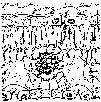
Transpiration: loss of water from leaves.
Animal Transport
Open circulatory system: blood is pumped into spaces
to bathe organs.
Closed circulatory system: blood remains in vessels.
Artery: vessel that takes blood away from the heart.
Vein: vessel that takes blood to the heart.
Capillary: functional unit of the circulatory system.
Erythrocyte: red blood cell; no nucleus. Transports
oxygen.
Leukocyte: white blood cell. Fights infection.
Platelet: cell fragment used in blood clotting.
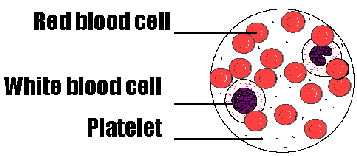
Atrium: upper chamber of the heart.
Ventricle: lower chamber of the heart.
Animal Circulation
Porifera: none.
Cnidaria: diffusion.
Platyhelminthes: diffusion.
Nematoda: diffusion.
Annelida: closed circulatory system; five pairs
of hearts.
Gastropoda: open circulation.
Bivalvia: open; pumping heart.
Cephalopoda: open; pumping heart.
Echinodermata: none.
Crustacea: open; pumping heart.
Arachnida: open; pumping heart.
Insecta: open; pumping heart.
Chondrichthyes: two chambered heart; closed circulation.
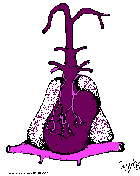
Osteichthyes: two chambered heart; closed circulation.
Amphibia: three chambered heart; closed circulation.
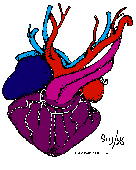
Reptilia: three chambered heart; partial septum
in ventricle; closed circulation.
Aves: four chambered heart; closed circulation.
Mammals: four chambered heart; closed circulation.
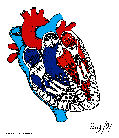
back
to notes!






